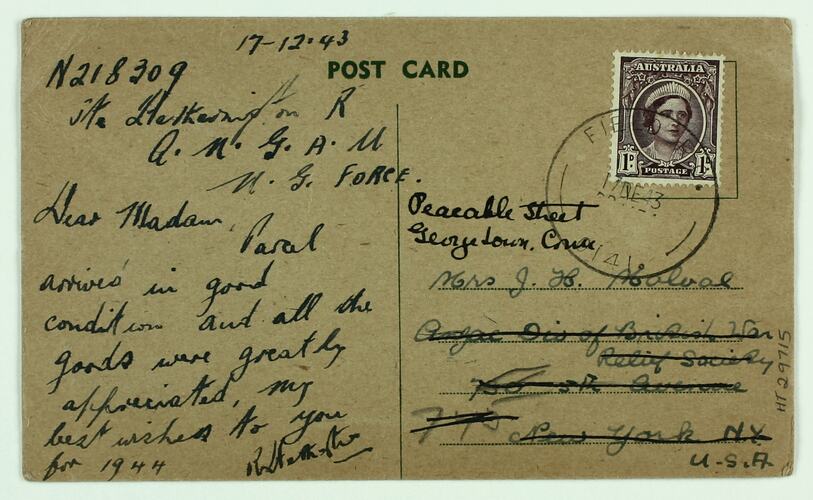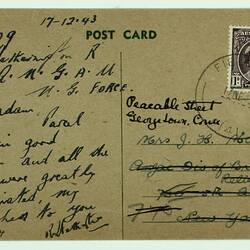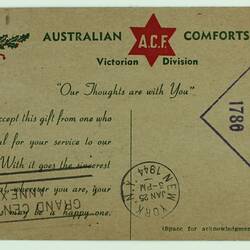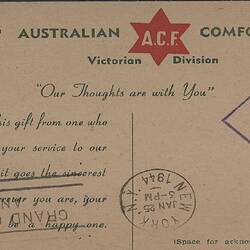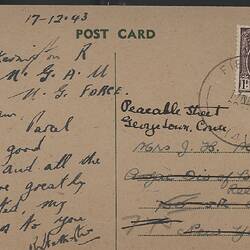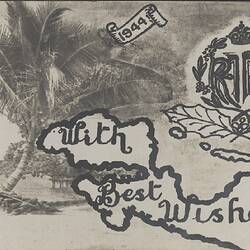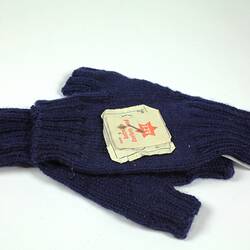Summary
Australian Comforts Fund postcard sent from Warrant Officer Roderick Hetherington, to Mrs. J. H Malval, dated 17 December 1943. The card would have accompanied a care package sent by Margaret Malval though the Australian Comforts Fund. On the card Roderick expresses his appreciation for the parcel and wishes her well for 1944.
Margaret Malval emigrated to the United States of America from Melbourne, Australia in 1935. During World War II she volunteered for the American Women's Voluntary Services and sent packages to Australian soldiers through the Australian Comforts Fund, thereby entering into an exchange of correspondence with a number of Australian soldiers based in the Pacific and in Australia.
Physical Description
Rectangular card with address [right hand side] and a handwritten message [left hand side] in blue ink on front. The card has a New York postmarked and there is a 3d Australian stamp in the top right corner. The back of the card has the Australian Comforts Funds logo, printed green text on the left hand side. There is a purple stamp on the right hand side noting that the card has been passed by censors.
Significance
This collection of letters and cards are significant as they illustrate the continuing ties felt by an emigrant to their country of birth. Margaret Malval was born and grew up in Melbourne, Victoria and moved to the United States of America to be married in 1935, where she lived for the rest of her life. Though her husband served in the United States Armed Forces, Margaret chose to send care packages to Australian soldiers through the Australian Comforts Fund, suggesting she retained strong ties to Australia.
These letters and cards were sent from Australian servicemen to Margaret, initially after receiving a care package from her which she donated through the Australian Comforts Fund. These letters and cards highlight the support of people on the home front for Australian servicemen by sending care packages through organisations like the Australian Comforts Fund, and the response of Australian Servicemen on receipt of these packages. Additionally, this collection also helps tell the stories of the frontline experience of Australian servicemen during World War II.
More Information
-
Collecting Areas
-
Acquisition Information
Donation from Ms Jeanne Cook, 05 Nov 2009
-
Sender
Warrant Officer Roderick M. Hetherington, New Guinea, 17 Dec 1943
Probably sent from New Guinea (now Papua New Guinea) -
Addressed To
Mrs Margaret L. Malval, Georgetown, Connecticut, United States of America, 17 Dec 1943
-
Inscriptions
On front of card, left hand side [handwritten in blue ink]: '17 - 12 - 43 / N218309 / Hetherington R / A.N.G.A.U / N.G. FORCE. / Dear Madam, / Parcel / arrives in good / condition and all the / goods were greatly / appreciated, my / best wishes to you / for 1944 R Hetherington' On front of card, right hand side [handwritten in black ink]: 'Peacable Street / Georgetown, Conn / Mrs J. H. Malval / U.S.A' On back of card, left hand side [printed in green ink]: 'AUSTRALIAN A.C.F COMFORTS FUND / Victorian Division / "Our Thoughts are with You" / Please accept this gift from one who / is grateful for your service to our / country. With it goes the sincerest / wishes that, wherever you are, your / Christmas may be a happy one.' On back of card, right hand side: purple stamp noting that the card has been passed by censors. [Printed in green ink] (Space for acknowledgment)
-
Classification
-
Category
-
Discipline
-
Type of item
-
Overall Dimensions
140 mm (Width), 85 mm (Height)
-
Keywords
Australians at War, Correspondence, Military Communication, Military History, Postcards, War Effort, War Service, Wars & Conflicts, World War II, 1939-1945, Soldiers' Comforts
